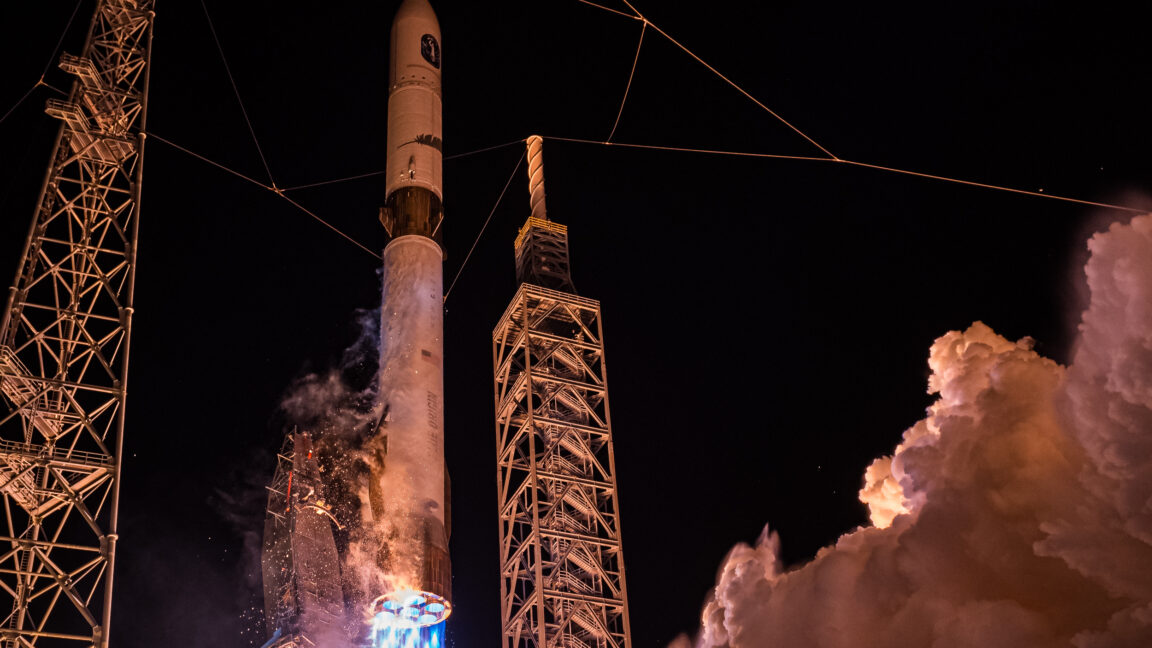Science
Blue Origin Aims for Success with New Glenn’s Upcoming Launch

Blue Origin is gearing up to launch its second New Glenn rocket, a critical mission for both the company and NASA. The upcoming flight will carry two NASA-funded satellites destined for Mars, aimed at studying the planet’s upper atmosphere and understanding its transformation from a warmer, wetter environment to the cold, arid landscape seen today. A successful launch would not only advance the scientific mission but also bring Blue Origin closer to securing certification from the U.S. Space Force for launching national security satellites.
The stakes are particularly high for the New Glenn program, as Blue Origin plans to use the same rocket booster for a subsequent lunar mission early next year. To achieve this, the company must successfully recover the rocket’s first stage booster during its upcoming launch, which is anticipated to take place no earlier than November from Cape Canaveral Space Force Station in Florida.
Challenges and Expectations for Recovery
During its inaugural flight in January, the New Glenn rocket reached orbit, a notable achievement for any first launch. However, the booster fell into the Atlantic Ocean after three engines failed to reignite in time for a safe landing. Following this, engineers implemented seven critical changes to address the issue, focusing on “propellant management and engine bleed control improvements.”
Pat Remias, Blue Origin’s vice president of space systems development, expressed confidence in the next launch, stating, “We fully intend to recover the New Glenn first stage on this next launch.” This determination is reflected in the booster’s nickname for the upcoming flight: “Never Tell Me The Odds.” Blue Origin’s leadership is betting on a successful touchdown, which would play a pivotal role in advancing their lunar ambitions, particularly for the third New Glenn launch scheduled for January 2024.
Aiming for the Moon
The payload for this third launch will be Blue Origin’s first robotic lunar lander, the Blue Moon Mark 1, which is designed to deliver up to 3 metric tons (approximately 6,600 pounds) of cargo to the Moon’s surface. At about 26 feet (8 meters) tall, it surpasses the height of the lunar landers used during NASA’s Apollo missions. The lander is funded entirely by Blue Origin and is currently assembled, with plans for testing at NASA’s Johnson Space Center in Houston before moving to Florida for final preparations.
Remias emphasized the company’s strategy of developing a series of lunar landers, stating, “We are building a series, not a singular lander, but multiple types and sizes and scales of landers to go to the Moon.” This approach includes plans for using the Mark 1 lander for various missions, including deploying NASA’s VIPER rover to search for water ice at the Moon’s south pole by late 2027.
The competitive landscape is intensifying, with China also pursuing lunar exploration and aiming for a crewed landing by 2030. As NASA prepares for its Artemis program to return humans to the Moon, the success of Blue Origin’s upcoming New Glenn launch could influence the timeline and strategy for U.S. lunar missions.
With many technical challenges ahead, the success of the New Glenn rocket’s next flight is paramount. Achieving a successful recovery would not only validate Blue Origin’s ambitious plans but also set the stage for future missions aimed at reestablishing human presence on the Moon. The next few months will be crucial as the company continues to refine its technology and prepare for what could be a landmark moment in its history.
-

 Education3 months ago
Education3 months agoBrandon University’s Failed $5 Million Project Sparks Oversight Review
-

 Science4 months ago
Science4 months agoMicrosoft Confirms U.S. Law Overrules Canadian Data Sovereignty
-

 Lifestyle3 months ago
Lifestyle3 months agoWinnipeg Celebrates Culinary Creativity During Le Burger Week 2025
-

 Health4 months ago
Health4 months agoMontreal’s Groupe Marcelle Leads Canadian Cosmetic Industry Growth
-

 Science4 months ago
Science4 months agoTech Innovator Amandipp Singh Transforms Hiring for Disabled
-

 Technology4 months ago
Technology4 months agoDragon Ball: Sparking! Zero Launching on Switch and Switch 2 This November
-

 Education4 months ago
Education4 months agoRed River College Launches New Programs to Address Industry Needs
-

 Technology4 months ago
Technology4 months agoGoogle Pixel 10 Pro Fold Specs Unveiled Ahead of Launch
-

 Business3 months ago
Business3 months agoRocket Lab Reports Strong Q2 2025 Revenue Growth and Future Plans
-

 Technology2 months ago
Technology2 months agoDiscord Faces Serious Security Breach Affecting Millions
-

 Education4 months ago
Education4 months agoAlberta Teachers’ Strike: Potential Impacts on Students and Families
-

 Education3 months ago
Education3 months agoNew SĆIȺNEW̱ SṮEȽIṮḴEȽ Elementary Opens in Langford for 2025/2026 Year
-

 Science4 months ago
Science4 months agoChina’s Wukong Spacesuit Sets New Standard for AI in Space
-

 Business4 months ago
Business4 months agoBNA Brewing to Open New Bowling Alley in Downtown Penticton
-

 Business4 months ago
Business4 months agoNew Estimates Reveal ChatGPT-5 Energy Use Could Soar
-

 Technology4 months ago
Technology4 months agoWorld of Warcraft Players Buzz Over 19-Quest Bee Challenge
-

 Business4 months ago
Business4 months agoDawson City Residents Rally Around Buy Canadian Movement
-

 Technology2 months ago
Technology2 months agoHuawei MatePad 12X Redefines Tablet Experience for Professionals
-

 Technology4 months ago
Technology4 months agoFuture Entertainment Launches DDoD with Gameplay Trailer Showcase
-

 Top Stories3 months ago
Top Stories3 months agoBlue Jays Shift José Berríos to Bullpen Ahead of Playoffs
-

 Technology4 months ago
Technology4 months agoGlobal Launch of Ragnarok M: Classic Set for September 3, 2025
-

 Technology4 months ago
Technology4 months agoInnovative 140W GaN Travel Adapter Combines Power and Convenience
-

 Science4 months ago
Science4 months agoXi Labs Innovates with New AI Operating System Set for 2025 Launch
-

 Technology4 months ago
Technology4 months agoNew IDR01 Smart Ring Offers Advanced Sports Tracking for $169










